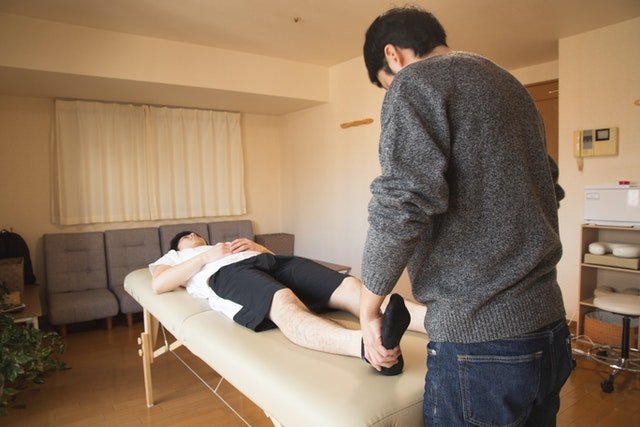A Look Into the Types of Therapy Available To Alleviate Pain in Your Feet
The most common cause of foot pain is a physical injury or damage to the feet, but it may also be caused by instability in other physiological joints. Impaired mobility and function in the back muscles, and pelvic area, including your hips and knees, may alter your standing and walking patterns, increasing the foot muscles and joints.
Something as simple as shoe insoles could provide significant relief for some individuals. They’re easily accessible without a prescription and can be bought over the counter. Others need additional treatment, such as shockwave therapy or physical therapy, to alleviate ongoing foot pain.

(Source)
Causes of Foot Pain
Many of us are completely oblivious of the influence that daily life has on our feet. Wearing shoes that are too tiny, too small, or too high may cause stress on our feet and eventually result in diseases. When we depend on our feet daily, overuse issues are especially prevalent. Among the conditions that might impact our feet are the following:
- Achilles Tendinitis
- Calluses, Bunions, or Corns
- Fallen Arches
- High Arches
- Bone Spurs
- Arthritis
- Metatarsal Syndrome
- Plantar Fasciitis
- Morton’s Neuroma
- Hallux Rigidus
- Sciatica
- Gout
Foot Pain Treatments And Therapies
Foot pain may vary from mildly irritating to totally incapacitating. Whether sports exacerbate the pain, work on your feet, or just standing while cooking supper, numerous treatments and therapies are practical non-surgical choices for persistent and chronic foot pain.
Shockwave Therapy
Shockwave therapy is a non-invasive treatment that produces a sequence of low-intensity acoustic wave pulsations that are immediately delivered to an injury through a gel medium via a person’s skin. The idea and technique arose from the finding that concentrated sound waves might break down kidneys and gallstones.
Shockwaves generated by a computer are effective in several scientific investigations to treat chronic diseases, including foot pain. Shockwave therapy provides physiotherapists with another treatment option for persistent, chronic tendonitis. Standard therapies may not work for specific tendon issues, but shockwave therapy is currently one of the most advanced and effective treatments available.
The treatment is a simple procedure that might leave you feeling better the following day. Shockwave treatment is not as shocking as it sounds, and it increases blood flow to affected regions, treating the cause of the issue and enabling therapy to last for an extended period of time.
Your feet will heal faster thanks to shockwave therapy. This is particularly significant given that surgery is unnecessary, and is inexpensive and does not need an anaesthetic. Because it is safe, this therapy is preferable to surgery.
Prolotherapy
The injection of a fluid to induce the formation of new cells to cure painful places is known as prolotherapy or proliferation therapy. The most usual injection sites are ligaments; however, muscles and tendons may also be treated.
Ligaments link bone to bone and surround all of our joints. They also contain many nerve endings, which may cause discomfort if they are overstretched! Ligaments grow loose over time due to our normal posture and everyday activity, and trauma may also cause injury to them.
A local anaesthetic and Dextrose are mixed in the injections. The concentration of Dextrose in the solution is high enough to irritate the injected tissue. This causes a modest inflammatory response in the affected region, the initial step in the healing process. The injections are painful, but the local anaesthetic soon helps the discomfort.
Injections of prolotherapy may produce better long-term benefits.
Physical Therapy
If you’ve had a significant injury to your foot, you may want to check into a specialised physical therapy programme. Physical therapy may help you increase your strength, mobility, and muscular strength while also focusing on specific muscles. Physical therapy can also help with issues like sports injuries and overuse injuries and difficulties like rehabilitation after foot surgery. The treatment plan for your foot and ankle injury will be determined by your unique condition and your doctor’s advice.
Prevention
To help avoid recurring foot discomfort, follow these tips:
- Choose shoes that are spacious, comfy, and well-cushioned.
- Avoid high heels and shoes with a tight toe region.
- Maintain proper foot hygiene.
- When you’re outside, always wear footwear to protect your feet.

(Source)
Conclusion
Treatment is determined by the underlying cause of your foot discomfort. Typically, after the root cause of the pain is addressed, the discomfort diminishes. You could try a few self-care methods and over-the-counter medications to alleviate foot discomfort. If you are experiencing significant pain, see a podiatrist or physician who may prescribe one of the treatments above to ease your persistent foot pain.
The post A Look Into the Types of Therapy Available To Alleviate Pain in Your Feet appeared first on GymGuider.com.
